

Fukushima 2014: Don't Forget (English subtitles) Tepco took months to release record strontium readings at Fukushima. Fukushima : des pompes déversent par erreur de l'eau ultra-contaminée dans des bâtiments. Une nouvelle pollution liée à la centrale accidentée de Fukushima.

Quatre pompes qui fonctionnaient par erreur ont répandu d'importantes quantités d'eau hautement radioactive dans divers bâtiments de la centrale nucléaire japonaise, selon un courriel de la compagnie Tokyo Electric Power (Tepco). Ces pompes qui ne devaient pas être en service ont été stoppées dans l'après-midi du dimanche 13 avril, mais entre-temps les sous-sols de deux bâtiments ont été inondés. Tepco a évalué à 203 m3 la quantité de liquide qui s'est répandu dans ces lieux d'incinération situés non loin des réacteurs mais censés rester secs. Cette eau a une teneur énorme en césium radioactif (137 et 134) évaluée à 37 millions de becquerels par litre. Fukushima: Tepco reconnaît un rejet massif de matière radioactive. Fukushima residents cleared to return home amid contamination fears.
Families are cleared to return to a district of Tamura City in Fukushima prefecture -- but is it worth the risk?
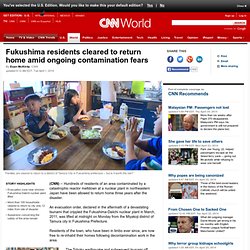
Evacuation zone near stricken Fukushima Daiichi nuclear plant liftedMore than 100 households cleared to return to city only 12 miles from site of disasterSuspicions concerning the safety of the area remain (CNN) -- Hundreds of residents of an area contaminated by a catastrophic reactor meltdown at a nuclear plant in northeastern Japan have been allowed to return home three years after the disaster. An evacuation order, declared in the aftermath of a devastating tsunami that crippled the Fukushima-Daiichi nuclear plant in March, 2011, was lifted at midnight on Monday from the Miyakoji district of Tamura city in Fukushima Prefecture. Residents of the town, who have been in limbo ever since, are now free to re-inhabit their homes following decontamination work in the area.
Estimated radiation doses of Fukushima returnees withheld for half a year. The government withheld findings on estimated radiation exposure for Fukushima returnees for six months, even though levels exceeded the long-term target of 1 millisievert a year at more than half of surveyed locations.

Individual radiation doses were estimated to be beyond 1 millisievert per year, or 0.23 microsievert an hour, at 24 of all the 43 surveyed sites, including ones in the Miyakoji district in Tamura, Fukushima Prefecture, The Asahi Shimbun learned April 15. The revelation comes just two weeks after the central government lifted the evacuation order for the district on April 1. Last July, the Cabinet Office’s working team in charge of assisting the lives of nuclear disaster victims asked the National Institute of Radiological Sciences and the Japan Atomic Energy Agency to measure air dose rates and estimate individual radiation doses at 43 locations.
It also intends to bring readings to 1 millisievert or less eventually. Survey: Fukushima evacuees traveled average 273 km in search for shelter. Evacuees from the Fukushima nuclear disaster moved to different shelters an average of four times and traveled 273 kilometers during the month after the crisis unfolded in March 2011, a survey showed.
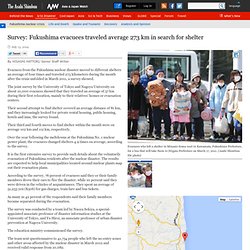
The joint survey by the University of Tokyo and Nagoya University on about 10,000 evacuees showed that they traveled an average of 57 km during their first relocation, mainly to their relatives’ homes or evacuation centers. Their second attempt to find shelter covered an average distance of 81 km, and they increasingly looked for private rental housing, public housing, hotels and inns, the survey found.
Their third and fourth moves to find shelter within the month were on average 102 km and 112 km, respectively. Over the year following the meltdowns at the Fukushima No. 1 nuclear power plant, the evacuees changed shelters 4.9 times on average, according to the survey. As many as 42 percent of the respondents said their family members became separated during the evacuation. The lights of Fukushima Daiichi by night. The Fukushima No. 1 nuclear power plant, foreground, shines in the darkness on Feb. 18.
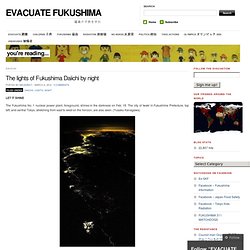
The city of Iwaki in Fukushima Prefecture, top left, and central Tokyo, stretching from east to west on the horizon, are also seen. (Yusaku Kanagawa) Seen from an altitude of 13,000 meters at night, the crippled Fukushima No. 1 nuclear power plant shone brightly in a sea of darkness amid the loneliness of the evacuation zone. The Asahi Shimbun flew its Asuka airplane over the municipalities of Fukushima Prefecture on Feb. 18. The plant was clearly visible because work to deal with the rising volume of contaminated water and to decommission reactors was actively ongoing, even at night. In stark contrast, near-complete darkness enveloped areas designated as difficult-to-return zones for residents surrounding the plant. Japanese gov't conceals high radiation data in Fukushima region from public.
The matter is that the three municipalities in question currently have an active evacuation order, which might be lifted soon, and the government supports the lifting.
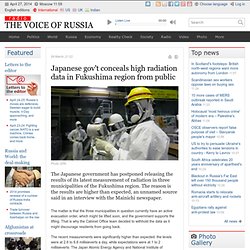
That is why the Cabinet Office team decided to withhold the data as it might discourage residents from going back. The recent measurements were significantly higher than expected: the levels were at 2.6 to 6.6 millisieverts a day, while expectations were at 1 to 2 millisieverts. The Japan Atomic Energy Agency and National Institute of Radiological Science decided to recalculate the results basing on an assumption that people would spend shorter periods outdoors than it is usually assumed in these cases (six hours instead of eight).
The new results were submitted to the Cabinet Office team, and they plan to announce them later this month. Fukushima : un séisme, un tsunami, une catastrophe nucléaire ... Parler de Fukushima trois ans après cette chaîne de catastrophes, parler de commémoration, parler d’anniversaire, parler de souvenir.

C’est le choix que beaucoup font aujourd’hui. Mais à la centrale nucléaire de Fukushima, nous ne sommes pas après la catastrophe. A Fukushima, le système de décontamination d'eau ne fonctionne plus. Fukushima : alors que la catastrophe dure depuis 3 ans, le déni continue. Fuites incontrôlées à la centrale de Fukushima Trois ans après, la situation à la centrale reste hors de contrôle.
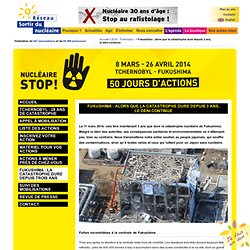
Les réacteurs éventrés doivent toujours être refroidis ; près de 400 000 tonnes d’eau s’accumulent dans des cuves construites à la va-vite, dont un grand nombre fuient. Les stations de traitement des eaux ne sont toujours pas opérationnelles et les fuites hautement radioactives ont déjà atteint la nappe phréatique et l’océan, contaminant gravement le milieu marin. Fukushima + 3. Former leaders say no to nuclear power, more on the aftereffects, and The New Republic misses the real middle. Former NRC Chair Greg Jaczko asks if Japan is ready for another nuclear accident: “This has to be remembered—that there are certain accidents that are not preventable,” said Gregory Jaczko, former chairman of the U.S.

Nuclear Regulatory Commission. “The question Japan has to ask itself is: Is the country willing to have another accident? And if the answer is no, then the answer has to be no more nuclear power.” In reality, the answer can only be no. No country in the world is prepared for a nuclear accident on the scale of Fukushima. Former Japanese Prime Minister Morihiro Hosokawa has joined his colleague Naoto Kan as an outspoken advocate for a nuclear-free future. Fukushima an III : sur la côte dévastée, la peur et la colère.
Dans les villes mortes autour de Fukushima. LE MONDE | • Mis à jour le | Par Philippe Pons (Préfecture de Fukushima, envoyé spécial) Dans le ciel, les corbeaux planent.
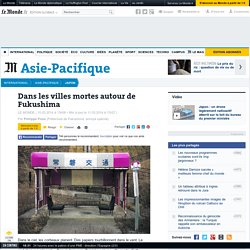
Des papiers tourbillonnent dans le vent. Le silence pesant des rues sans vie est rompu par une porte qui claque ou des tôles ondulées qui grincent… Depuis trois ans, Tomioka est une ville morte. Cette commune de 16 000 habitants du nord-est du Japon avait résisté au puissant séisme du 11 mars 2011, et au tsunami qui l'avait suivi. Fukushima disaster: Plan to send residents home three years after nuclear accident labelled 'irresponsible' By North Asia correspondent Matthew Carney Updated Tue 11 Mar 2014, 3:04pm AEDT A nuclear industry insider has told the ABC that the situation at the stricken Fukushima reactor is still not under control, three years after the disaster there. Japan's prime minister Shinzo Abe has announced he wants 30,000 residents to return to their homes and the reactors to be switched back on within two years.
But a Fukushima insider and two former prime ministers have told the ABC's 7.30 program that such a move would be irresponsible. At the risk of losing his job if his identity is revealed, a man who worked at TEPCO's Fukushima plant for more than 20 years says the situation at the reactor is not under control and no-one knows how to fix the problem. Thousands stage anti-nuclear rally in Tokyo ahead of Fukushima anniversary - Australia Network News. Updated Mon 10 Mar 2014, 7:33pm AEDT Tens of thousands of Japanese citizens have turned out for an anti-nuclear rally in Tokyo, as the nation prepares to mark the third anniversary of the Fukushima disaster.
Demonstrators congregated at Tokyo's Hibiya Park on Sunday, close to central government buildings, before marching around the national parliament. Anti-nuclear rally in Tokyo draws tens of thousands. Tens of thousands of citizens turned out for an anti-nuclear rally in Tokyo on Sunday, as the nation prepares to mark the third anniversary of the Fukushima disaster.
Demonstrators congregated at Hibiya Park, close to central government buildings, before marching around the national parliament. They gathered to voice their anger at the nuclear industry and the government of Prime Minister Shinzo Abe, who has called for resumption of nuclear reactors to power the world's third largest economy. "I felt it's important that we continue to raise our voice whenever possible," said Yasuro Kawai, a 66-year-old businessman from Chiba prefecture, east of Tokyo. "Today, there is no electricity flowing in Japan that is made at nuclear plants. Japon: les antinucléaires manifestent pour les 3 ans de Fukushima. Tokyo - Des dizaines de milliers de personnes ont participé à une manifestation antinucléaire à Tokyo dimanche à l'approche du troisième anniversaire de la catastrophe de Fukushima, le pire sinistre nucléaire depuis celui de Tchernobyl. Les manifestants se sont rassemblés dans le parc Hibiya au coeur de la capitale, à deux pas des ministères et autres bâtiments gouvernementaux, avant de marcher vers le parlement.
Ils ont fustigé l'industrie nucléaire et le Premier ministre Shinzo Abe qui plaide depuis son retour au pouvoir il y a un peu plus d'un an pour que soient relancées les centrales de l'archipel, arrêtées par précaution après l'accident de Fukushima. Il juge cette énergie indispensable à un archipel dépourvu de ressources naturelles. «Il est important que nous continuions à nous faire entendre», expliquait un manifestant, Yasuro Kawai, 66 ans, venu de la préfecture de Chiba, à l'est de Tokyo. Fukushima, chronique d'un désastre. WE Japon - Fukushima.